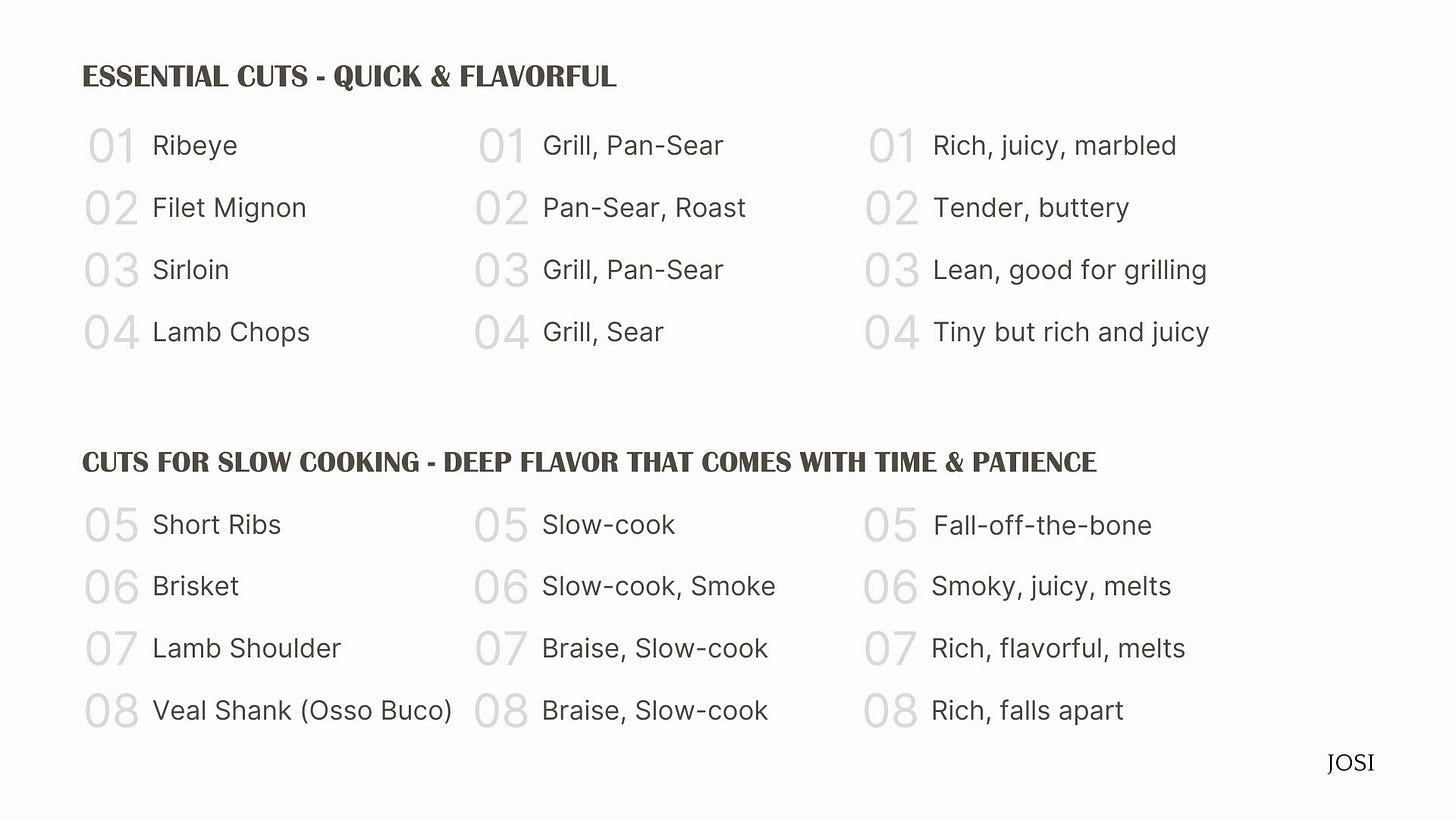I don’t know what I was thinking, this title sounds like the beginning of a horror movie…. Bear with me, it’s not that bad. But stepping into a butcher shop always makes me feel slightly out place. Put me in the middle of a cheesemonger and I’ll never leave, But meat, that’s another story.
Now, don’t get me wrong, I love a good ribeye or a slow-cooked brisket. It’s not the meat itself that intimidates me, it’s the experience. Or rather, my complete ignorance about it.
My experience usually goes like this: I pick a recipe, make a note of exactly what’s needed: cut, size, quantity. I head to the butcher with my little paper and confidently repeat what the recipe says, and then, inevitably the questions start:
‘Bone-in or boneless? Trimmed or tied? Or my favourite ‘which thickness?’
And that’s where the panic sets in. I freeze. I have no idea. I nod and mumble something about ‘what the recipe says’ while praying I don’t accidentally order a whole side of beef.
Cooking meat has never been my strong suit, either. As you’ve probably seen, I am more of a baker. Searing, resting, not for me: a cooking mistake with meat feels unforgivable, there’s no coming back from dry lamb or overcooked beef. Give me a slow-cooked stew, and I’m happy. No stress, just patience and the right pot, of course!
Maybe that’s why butchery, and the art of cooking meat, has always felt like a man’s world. Am I the only woman who feels this way?
Clearly, my approach isn’t working, so I’ve decided to take matters into my own hands meaning: learn the language, the cuts, and the rules. Here’s my personal cheat sheet to make my next butcher visit (slightly) less awkward.
101 at the butcher
CUTS, COOKING METHOD AND FLAVORS
Personally, I like things to be efficient so I focused only on the ones I might actually cook. So here’s my shortcut version: a few cuts, how to cook them, and why they matter.
THE VOCABULARY TO FEEL LIKE A PRO
Marbling: The white streaks of fat in the meat. The more fat, the more flavour. It is a question of taste. I’m all about the fat!
Dry-Aged vs. Wet-Aged: Dry-aging is when the meat is stored in a temperature controlled environment with nothing but air. It can last weeks or even months. Wet-aged is when the meat is vacuum-sealed in its own juices to make the meat as tender as possible while keeping its moisture. We are getting technical…!
Silver skin: The tough, shiny membrane on meat that needs to go before cooking.
Searing: Cook the surface of meat at high heat first to create a deep brown, flavorful crust.
Reverse sear: Cook low fand slow first, then hit it hard for the perfect crust.
Confit: French word for slow-cooking in fat.
Braising: Low and slow cooking to get the melt-in-your-mouth meat.
Frenched: When a butcher trims the meat off the end of the bone for a fancier look. Think lamb chops, pork racks etc…
I’m sure I am missing many so please help me filling this list and add words/concepts that are not obvious to everyone.
COMMON MISTAKES (THAT I HAVE MADE SO YOU DON’T HAVE TO)
Cooking cold meat straight from the fridge. Let it sit out for 30–60 minutes to come to room temperature. This ensures even cooking.
Not patting the meat dry. Moisture is the enemy of a good sear. (This applies to chicken too.)
Messing with the meat while it cooks. Guilty. I used to constantly check, flip, and poke, mostly out of fear I’d ruin it. Turns out, the best thing you can do is nothing. Let it be, trust the process.
Skipping the resting time. Give it 10–15 minutes before slicing.
Cutting the meat the wrong way. Look for the lines (the muscle fibers) and cut against them. This makes even tough cuts more tender. Honestly, I never knew this was a thing, so making a mental note.
Meat as an art
Today, meat often comes with a stigma due of its environmental impact. But for centuries, it has been a cornerstone of the food culture. Now more than ever, eating meat comes with a responsibility: to be thoughtful about where we source it and how we consume it.
Sustainability in meat isn’t just about ethical sourcing; it’s about using every part wisely. This isn’t always something we can achieve at home, but it’s where the nose-to-tail philosophy comes in. Butchers and chefs who embrace this approach see the whole animal as an opportunity, transforming overlooked cuts into something delicious. It’s a way of cooking that values skills over convenience and time over waste.
One of the main pioneer of the nose-to-tail philosophy is Fergus Henderson, chef and founder of St John in London opened in 1994. St John became the temple of nose-to-tail dining. Henderson’s philosophy is simple: “If you’re going to eat and animal, it seems only polite to eat it all”!
In the hands of those who respect the craft, butchery isn’t just a trade, it’s actually an art.
Oh and if you’ve never been to St John and this type of cooking is your thing, make sure to book ASAP. You can also show up at their Farringdon original restaurant early, grab a drink in the bar and eat from the shorter but great menu without booking!
Stay cosy until next time!







